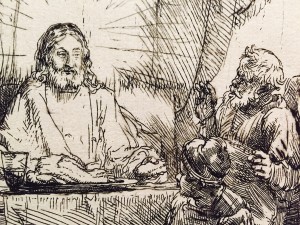
Rembrandt, “Christ Appearing” (portion of print at University of San Diego, Hoehn Family Galleries).
As you study Jesus’ parables’, it becomes quickly obvious how important the Sower and the Seed story is, one of the few to appear in all three synoptic Gospels. (John’s Gospel doesn’t contain any parables.)
Even more noticeable is that the Sower and the Seed story headlines the rest–in Matthew (Matt. 13:3-17), Mark (Mark 4:1-9) and Luke (Luke 8:4-8) where the majority of parables cluster. Are bells and whistles dinging somewhere for us right now, prompting questions like: why is this parable so significant? What are the three Gospel writers trying to tell us by such premier placement?
First, most of the parables Jesus tells are colorful — and sometimes enigmatic — stories about the Kingdom of God. Perhaps the Sower parable leads the rest because its focus is how we receive the message of the Kingdom, more than about the Kingdom itself. We learn of four states of soil, or thought, that exhibit various conditions. Only in the fourth are the conditions of soil and cultivation right for harvest.
Jesus not only tells the parable to a crowd but also goes through an explanation of what it means. For that, Jesus turns back to one of the great Hebrew prophets: Isaiah, quoting Isaiah 6:9-10 in the Mark version of the story. Through the prophet, the Master Christian underscores the need for spiritually receptive, hungry hearts.
They may indeed look, but not perceive,
and may indeed listen, but not understand;
so that they may not turn again and be forgiven.’” (Mark 4:12)
Is Jesus wondering if the resistance Isaiah experienced will be any different 600 years later in his own day? The warning of hardness of heart and deafness to the message is repeated again and again throughout the Gospels. Since their intent is to bring about good discipleship, it makes sense the profound parables that have become such a loved part of The New Testament would begin with what many call this ‘parable of parables’ – how the good soil readies itself for that incomparable seed.
But there is another way to gain insight into this parable and it’s through a technique the gospel writer, Mark, uses called bracketing, or placing relevant material on either side of his key point. (Think of this a little like a peanut butter and jelly sandwich where the parable is the yummy inside and the before and after the two pieces of bread!)
Mark 3:31-35 sets up the story (the first piece of ‘bread’):
31 Then his mother and his brothers came; and standing outside, they sent to him and called him. 32 A crowd was sitting around him; and they said to him, “Your mother and your brothers and sisters are outside, asking for you.” 33 And he replied, “Who are my mother and my brothers?” 34 And looking at those who sat around him, he said, “Here are my mother and my brothers! 35 Whoever does the will of God is my brother and sister and mother.”
This passage seems pretty harsh, with Jesus referring to his family as being outside (a key word, we’ll discover). After the parable appears as the middle portion (Mark 4:1-9), a final section (the second piece of ‘bread’) follows returning to the theme of outsiders, but this time citing a different example.
11 And he said to them (the disciples), “To you has been given the secret of the kingdom of God, but for those outside, everything comes in parables” (Mark 4:10-12).
The first outsiders are his family and the second, the crowds (as distinct from his disciples). Is the placement of the parable, both in this ‘sandwich’ position and first in the line up, telling us that spiritual receptivity is the first qualification for those who truly follow Jesus and will be the true insiders?
While ‘insiders and outsiders’ is not very politically correct today, what if its Jesus’ way of describing his followers or disciples? If we want to be a true follower, an insider, then spiritual receptivity, the parable explains, must be our measure.
Likewise, those outsiders are similar to three of the four conditions of soil that prevent productivity and high yield. By not yielding to ‘the will of God’, how Jesus defines his family in the first passage, our ‘soil’ won’t be sufficient to produce a harvest. Happy cultivating!
(For more on the parables, you might enjoy this earlier blog if you missed it.)




Sorry, I put this response in the wrong place. I have been thinking a lot about this parable and what is required to be a follower of Chrst Jesus. On the surface it looks as if some are excluded from the kingdom, from ever being able to understand Jesus’ teachings. However, I think what Jesus is really pointing to is the need to be willing to look beyond material sense testimony to see what is true. Verses 14 -16. Hearing and seeing require listening and expectancy. I remember someone sharing a story about a Sunday School teacher who told the… Read more »